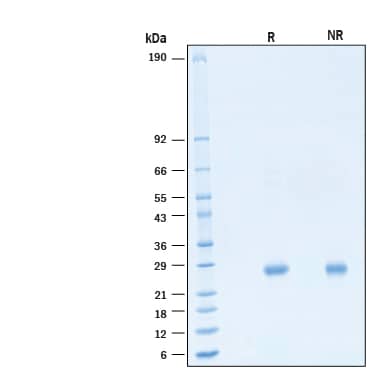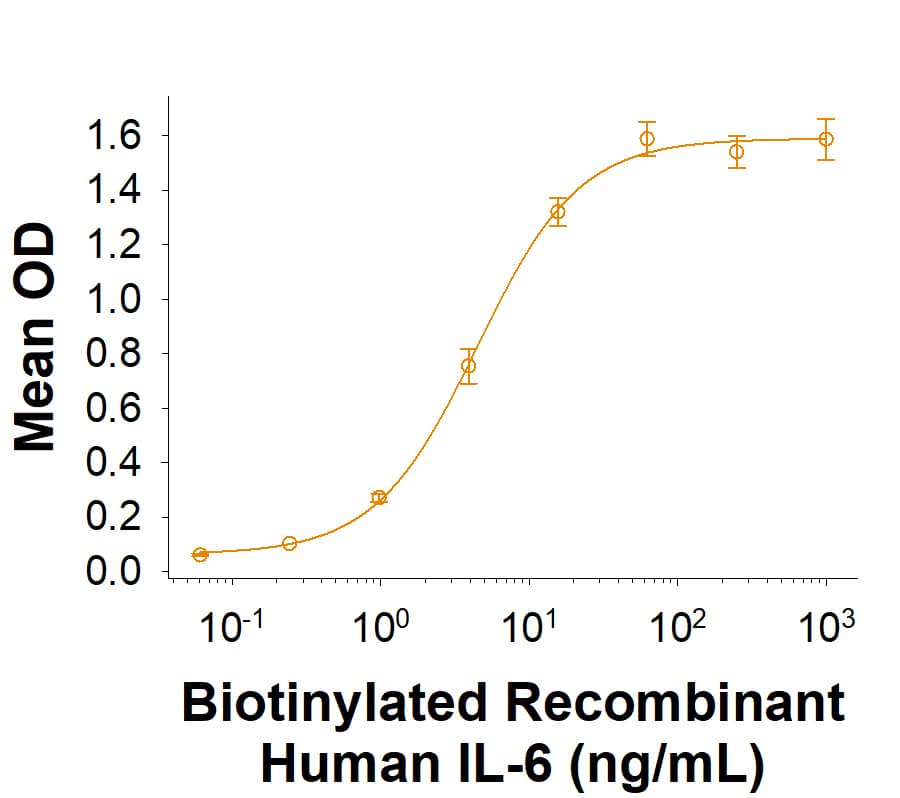Recombinant Human IL-6 (HEK293-expressed) Biotin Protein, CF
R&D Systems, part of Bio-Techne | Catalog # BT7270B
Biotinylated

Key Product Details
Source
HEK293
Accession #
Structure / Form
Biotinylated via amines
Conjugate
Biotin
Applications
Bioactivity
Product Specifications
Source
Human embryonic kidney cell, HEK293-derived human IL-6 protein
Val30-Met212
Val30-Met212
Purity
>95%, by SDS-PAGE visualized with Silver Staining and quantitative densitometry by Coomassie® Blue Staining.
Endotoxin Level
<0.10 EU per 1 μg of the protein by the LAL method.
N-terminal Sequence Analysis
Ala28 & Val30
Predicted Molecular Mass
21 kDa
SDS-PAGE
21-30 kDa, under reducing conditions.
Activity
Measured by its binding ability in a functional ELISA.
Biotinylated Recombinant Human IL-6 (Catalog # BT7270B) binds to Recombinant Human IL-6R alpha His-tag (Catalog # 10537-SR). The ED50 for this effect is 2.50-40.0 ng/mL.
Biotinylated Recombinant Human IL-6 (Catalog # BT7270B) binds to Recombinant Human IL-6R alpha His-tag (Catalog # 10537-SR). The ED50 for this effect is 2.50-40.0 ng/mL.
Scientific Data Images for Recombinant Human IL-6 (HEK293-expressed) Biotin Protein, CF
Biotinylated Recombinant Human IL‑6 Protein Binding Activity.
Biotinylated Recombinant Human IL-6 Protein (Catalog # BT7270B) binds to Recombinant Human IL-6R alpha His-tag (10537-SR). The ED50 for this effect is 2.50-40.0 ng/mL.Biotinylated Recombinant Human IL‑6 Protein SDS-PAGE.
2 μg/lane of Biotinylated Recombinant Human IL‑6 Protein (Catalog # BT7270B) was resolved with SDS-PAGE under reducing (R) and non-reducing (NR) conditions and visualized by Coomassie® Blue staining, showing bands at 21-30 kDa.Formulation, Preparation and Storage
BT7270B
| Formulation | Lyophilized from a 0.2 μm filtered solution in PBS with Trehalose. |
| Reconstitution | Reconstitute at 500 μg/mL in PBS. |
| Shipping | The product is shipped at ambient temperature. Upon receipt, store it immediately at the temperature recommended below. |
| Stability & Storage | Use a manual defrost freezer and avoid repeated freeze-thaw cycles.
|
Background: IL-6
References
- Mansell, A. and B.J. Jenkins (2013) Cytokine Growth Factor Rev. 24:249.
- Schuett, H. et al. (2009) Thromb. Haemost. 102:215.
- Erta, M. et al. (2012) Int. J. Biol. Sci. 8:1254.
- Garbers, C. et al. (2012) Cytokine Growth Factor Rev. 23:85.
- Mihara, M. et al. (2012) Clin. Sci. (Lond.) 122:143.
- Hirano, T. et al. (1986) Nature 324:73.
- Kestler, D.P. et al. (1995) Blood 86:4559.
- Kestler, D.P. et al. (1999) Am. J. Hematol. 61:169.
- Bihl, M.P. et al. (2002) Am. J. Respir. Cell Mol. Biol. 27:48.
- Alberti, L. et al. (2005) Cancer Res. 65:2.
- Murakami, M. et al. (1993) Science 260:1808.
- Muller-Newen, G. (2003) Sci. STKE 2003:PE40.
- Mitsuyama, K. et al. (2006) Clin. Exp. Immunol. 143:125.
- Cerutti, A. et al. (1998) J. Immunol. 160:2145.
Long Name
Interleukin 6
Alternate Names
BSF-2, BSF2, IFNB2, IL6, MGI-2A
Entrez Gene IDs
Gene Symbol
IL6
UniProt
Additional IL-6 Products
Product Documents for Recombinant Human IL-6 (HEK293-expressed) Biotin Protein, CF
Product Specific Notices for Recombinant Human IL-6 (HEK293-expressed) Biotin Protein, CF
For research use only
